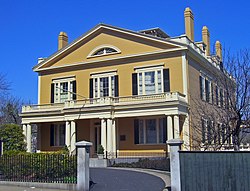 | |
| Abbreviation | WHALE |
|---|---|
| Formation | 1962 |
| Founder | George Perkins, Stephen Delano, and Peter Grinnell |
| Legal status | 501(c)(3) organization |
| Purpose | Historic Preservation |
| Headquarters | 15 Johnny Cake Hill, New Bedford, Massachusetts |
| Coordinates | 41°38′07″N70°55′25″W / 41.635308°N 70.923724°W |
| Membership | ≈872 |
Executive Director | Erin D. A. Miranda |
President | Diana Henry |
| Website | https://waterfrontleague.org/ |
The Waterfront Historic Area LeaguE, also known as WHALE, is a non-profit historic preservation organization located in New Bedford, Massachusetts. Its mission is: "to promote the value and reuse of greater New Bedford's historic structures through preservation, education and advocacy". [1] The organization often promotes its cause with the words of Sarah Delano (President of WHALE, 1966-1982). Delano said, "If you bulldoze your heritage, you become just anywhere". [2]







